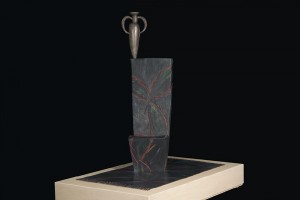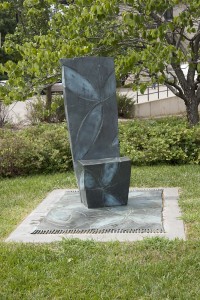Please join us as we post information about pieces in the Marianna Kistler Beach Museum of Art’s permanent collection from …to build up a rich collection… Selected works from The Marianna Kistler Beach Museum of Art.
All pieces in this series are on display now at the museum. We hope you will join in the discussion and enjoy learning in-depth about the heart of the museum, our permanent collection. As you walk in the front doors, and again while in the galleries you see these two pieces by artist Wendell Castle. What do these pieces make you wonder?

Mahogany and acrylic on aluminum
KSU, Beach Museum of Art, purchased with funds provided by Nancy Benedict, Wayne Castle, and Wendell Castle in honor of Marvin Oliver Castle, class of 1931 and Bernice Decker Castle, class of 1931; and with funds provided by the G. E. Johnson Art Acquisition Fund
Wendell Castle is among the most important figures in the Studio Craft movement, a watershed development in the history of the twentieth-century art. In the late 1950s artists working in the craft tradition began to adopt many of the ideas about and approaches to object making that has previously been considered the purview of fine art. This resulted in an eschewal of many previously help beliefs regarding materials and the privileging of utility. Artists associated with the movement began to move away from the production of mass-produced functional objects toward the creation of unique or limited edition, and not necessarily utilitarian, objects. The blurring of the distinction between fine are and craft wrought by the Studio Craft movement anticipated and contributed to a similar development that achieved considerable momentum in the fine arts by the 1970s.
Born in Emporia, Kansas, and raised in Holton, Kansas, Castle attended the University of Kansas, where he earned a B.F.A. in industrial design and an M.F.A. in sculpture in 1958 and 1961 respectively. Castle is perhaps best known for his inventive sculptural creations that take the form of furniture. Operating in the realms between furniture and art, and between art and craft, Castle’s work is characterized by his consummate craftsmanship and his witty, sophisticated, and playful approach to materials. All of Castle’s work is sculptural in nature; some is functional and some is not. For example, Castle’s Molar Chair of 1969-70, a canonic work in the history of twentieth-century design, was created as a production piece. The glass-reinforced polyester chair was manufactured by Northern Plastics Corporation and distributed by Stendig and Beylerian Limited. Castle’s Ghost of 1985, on the other hand, is a tour de force of trompe l’oeil sculpture in mahogany featuring a tall case clock nearly completely covered with a fabric sheet. Unlike, Molar Chair, this work has no practical application. Its utility is purely aesthetic and conceptual.

Bronze with patina
KSU, Beach Museum of Art, purchased with funds provided by Nancy Benedict, Wayne Castle, and Wendell Castle in honor of Marvin Oliver Castle, class of 1931 and Bernice Decker Castle, class of 1931
Chair on Painted Rug and Mid-Summer are wonderful examples of Castle’s propensity for playfully calling into question our conventionally held beliefs about the nature of art, craft, and materials. Both works testify to Castle’s proclivity for cross-pollination between and across materials, media, and function. Chair on Painted Rug is constructed of a block of mahogany carved in the shape of a chair, which is mounted on a rug made of aluminum, both of which have been incised with a chainsaw and painted. By painting the surface of the mahogany, Castle has obscured, and thus denied, the wood’s true nature. The painted surface also mitigates the piece’s ability to function as furniture because of the preciosity it imparts to the object. The leafy, organic painted imagery draped over chair and rug functions as an independent yet unifying element, serving to coalesce the disparate materials of mahogany and aluminum.
Mid-Summer, a bronze interpretation of Castle’s idea, is equally mischievous. The treatment of surface and form of the piece, installed out-of-doors, mimics the material of its mahogany and aluminum counterpart. Yet, unlike Chair on Painted Rug, it operates in both the aesthetic and functional realms. Because Mid-Summer is made of bronze, visitors to the grounds of the Beach Museum of Art are allowed to sit in the chair, which is a fine place to ponder the logic that prohibits them from doing the same in Chair on Painted Rug. BN